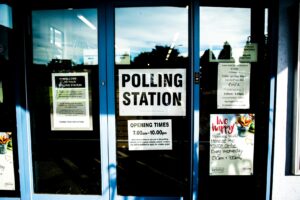National issues or local factors? Where the balance lies in influencing how people vote in local elections is widely discussed, but rarely agreed upon. As we reported in our previous ‘Super Thursday’ blogpost, research for this set of local elections by the University of Essex suggests that the pandemic will push local factors into the background.
So, can the Westminster voting intention opinion polls shed any light on possible outcomes in the West of England (and potentially elsewhere)?
There are caveats. Outside of a general election, most opinion polls are not regionalised, so it is difficult to interpret how Westminster figures can be applied precisely to local areas. Also, looking back to when local elections were previously fought in some West of England councils (e.g., 2016 and 2017), UKIP was a significant influence on voting intention. Now, it is not.
However, we can paint some broad brushstrokes which indicate how the parties may fare on 6 May 2021.
Today’s picture
Using the Politico Poll of Polls which aggregates different opinion polls together, we can see the Conservatives are on 43% with Labour on 35%. Other parties support varies from 1% – 8% (the Liberal Democrats). Contrasting with the General Election result in 2019, there is not a seismic difference. The Conservatives’ share of the vote was 43.6% and Labour’s was 32.2%.
- So, nationally, we are at practically the same point with voting intentions as the last set of mass elections in December 2019. Will a similar political map to 2019 be drawn in 2021 in the West of England when the votes are counted?
Lockdown politics – one year on
Would the Conservatives have enjoyed more favourable political conditions in May 2020? Yes.
The Tories’ polling was at 49% while Labour was at 32%. Again, the other parties were around the same mark as today. Remember, as the Government’s performance on the pandemic was perceived to falter, the opinion polls narrowed quite considerably between Autumn 2020 and January 2021 – Conservative and Labour were neck-and-neck.
- The Government’s ‘vaccine bounce’ has injected new life into the chances of Conservatives up and down the country. For the Conservative candidates protecting small majorities, the national background is not as favourable as a year ago, but very close, with no sustained Labour surge in the polls.
Where were the national polls at the last local elections?
In 2016, with a David Cameron-led Government, the Conservatives were on 35% and Labour 31%, with UKIP on 16%. These national conditions were the landscape for Labour sweeping to power in Bristol, capturing both the Mayoralty and overall control of the council chamber for the first time since 2003. UKIP was not a factor in the Bristol City Council elections, standing in only a handful of seats.
- With the Conservatives’ national polling significantly higher than in 2016, could they increase their share of the council seats in Bristol in 2021? This will be challenging. For an indication why, look no further than the swing Bristol North West parliamentary seat where, despite an exceptional national vote performance, the Tory share of the vote in 2019 slipped even further than in June 2017.
- For Labour, the prospect of a ‘high water mark’ 2016 local election result looks likely and with the anchor of Mayoral incumbency this could endanger some Labour council seats to other parties, especially the Green Party in some parts of central Bristol.
In 2017, UKIP had disappeared. Two-party national politics was back (temporarily). Despite a catastrophic end, Theresa May was on the crest of a wave in the opinion polls with a 17-point gap between the Tories and Labour (47%: 30%). The results in May in councils with Conservative parliamentary strongholds, such as Gloucestershire County Council and Wiltshire Council, returned more Tory councillors than in 2013.
But in the West of England Combined Authority mayoral race, the Labour vote in Bristol (counted as a single ‘constituency’ in addition to South Gloucestershire and B&NES) registered nearly 30% of first round preference to be convincingly top of the poll. Second preference votes were even stronger. Despite a weaker national backdrop, the strong base founded by Labour in 2016 maintained its strength.
- With seas of blue parliamentary seats in Gloucestershire and Wiltshire, the vaccine poll bounce, and significant councillor incumbency in these council areas, this does not feel like an opportunity for Labour, Liberal Democrats or Greens to advance at this election.
- Despite the Tory national lead, the 2017 WECA race was so close that even the marginal closure of Westminster opinion polling since could make this fight even tighter between Labour and the Conservatives. That view does not even consider the inevitable turnout differential between Bristol and other West of England councils.
Overall, based upon the national polling conditions, we could be heading towards a ‘status quo’ local election in many areas of the West of England where history really does repeat.

Matthew Bacon Account Manager
Contact



